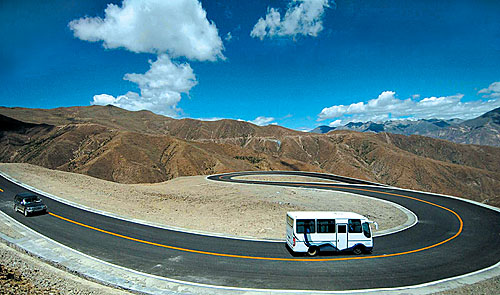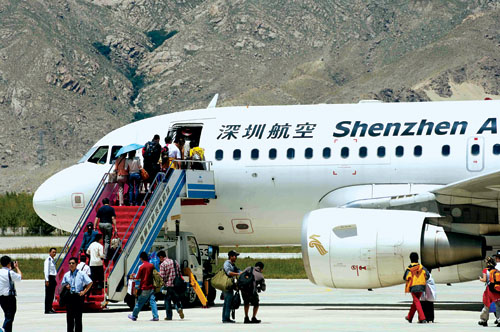|
 The year 2007 saw faster construction of highways in Tibet. Highway mileage open to traffic now reaches 486,000 km.
The year 2007 saw faster construction of highways in Tibet. Highway mileage open to traffic now reaches 486,000 km.
On July 1, 2006, the opening of the Qinghai-Tibet Railway, the key project of western development, finally provided Tibet with access to a railway. It helped Tibet form an increasingly integrated transportation system comprising railway, civil aviation and highways, which greatly improved transportation capacity and reduced the cost of materials transported to and from the region.
In 2007, Tibet moved 3.8482 million tons of goods, a rise of 6.7 percent from 2006, including: 124,100 tons via railways; 3.6 million tons via highways, a rise of 4.1 percent; 11,800 tons by air, up 10.2 percent; and 112,300 tons via pipelines, down 3.4 percent. Meanwhile, the year also saw a volume of passenger traffic of 6.801 million person times, an increase of 12.3 percent, including: 888,500 person-times via railways, up 29.1 percent; 4.6 million by highways, an increase of 3.4 percent; 1.3125 million by air, up 19.2 percent. Total telecom business amounted to 3.093 billion Yuan, up 43.5 percent.
Highways
In 2007, Tibet continued accelerating highway construction. The construction of such trunk roads as the Sichuan-Tibet Highway, Yunnan-Tibet Highway, Xinjiang-Tibet Highway and China-Nepal Highway and asphalt road in Tungxian County, as well as roads in rural areas, was remarkably quickened. The provincial and national highways enjoyed better traffic condition.
Tibet has also worked actively to adjust the road transportation structure, adding regular buses and tourist buses on popular routes and opening seven new routes for passenger traffic in rural areas. Lhasa Newu Passenger Transportation Station and nine county-level passenger transportation stations met the demands of economic and social development and have promoted growth of the transportation industry in an all-round way. At the end of 2007, highways open to traffic stretched 486,000 km, increasing by 3,798 km from 2006, of which, paved roads extended 2,537 km, a rise of 553 km. Another five counties gained access to asphalt roads. Currently, some 612 towns and 3,525 administrative villages in Tibet have gained access to highways, accounting for 92 percent and 71 percent respectively of the regional total. The asphalt roads extend 4,714 km in 43 counties. A highway network mainly comprised of five national highways which connect the towns and villages and extend beyond the region has preliminarily been formed. This makes it possible for more and more farmer and herders to get out of the remote mountains and plains and enter the market economy. By the end of 2007, the total number of motor vehicles for civilian use reached 159,100, up 12.6 percent over 2006.
Aviation
 Lhasa Gonggar Airport. Aviation transportation is important for Tibet today.
Lhasa Gonggar Airport. Aviation transportation is important for Tibet today.
Tibet has Lhasa Konggar, Qamdo Bangdam and Nyingchi airports, with 14 routes leading to Beijing, Shanghai, Guangzhou, Chengdu, Chongqing, Kunming, Xi'an and Xining, and so on, one international route to Katmandu, as well as charter flights to Hong Kong. In July 2006, air passenger transportation entered a new period of high-speed development alongside with the opening to traffic of the Qinghai-Tibet Railway. In 2007, Tibet handled 1.3125 million person-times by air, an increase of 19.2 percent, and 11,800 tons of cargo, up 10.2 percent.
|
